General Introduction to the Philippine Culture
The Philippines is a country rich in human and natural resources, but also known as the oldest democracy in Asia. However, the country is facing many problems that stem from a high level of corruption and little state security (see also water corruption), and an underdeveloped domestic market that results in a high level of poverty as well as health and social hazards (REESE 2006). Concerning Philippines WASH services, the absence of a clear national regulatory framework in this sector combined with high poverty levels have led to the situation that less than 10% of Filipinos are currently connected to a sewage system, and most flush toilets work with a septic tank (DOH 2010). Natural hazards like tropical storms are a constant phenomenon on the more than 7000 islands, and constitute a large risk for the population and the already instable water and sanitation situation.
More than 80% of the Philippine population are Roman Catholics, whilst around 5% are Muslims. Religion plays an important role in Philippine culture and is practised and shown regularly in everyday life. Furthermore, Filipinos have a strong sense of community. Families as well as communities are organised in strict hierarchies, and due to a lack of security concerning health care and income, it is common to live within strong family and community bonds (GIZ 2012).

The Philippines consist of more than 7, 000 islands and are located in Southeast Asia. Source: ZECH (2011)
Background
Xavier University-Ateneo de Cagayan (XU-Ateneo), located in the Philippines, is an academic institution having three clusters: academics, training and extension.
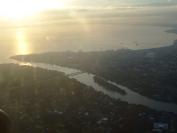
Cagayan de Oro City, seaside and river. Source: ZECH (2011)
Extension activities are the activities conducted by Xavier University faculty, staff and students outside the campus, extending help to the community, especially in Northern Mindanao. It is an aim of XU that any extension activities should be research-based or backed with research so that data collection and record keeping of activities and interventions are properly considered. One important extension and outreach activity is the “Sustainable Sanitation and Health Program” Convergence Project, situated in Barangay Lumbia (see also sustainable sanitation and the chapter invalid link).
Poor sanitation is a serious problem in Lumbia. Hundreds of families do not have access to basic sanitation facilities, including the access to safe water (see also access to water and sanitation), which is why the XU convergence project came into action. When typhoon Sendong hit the coast of Northern Mindanao in December 2011, thousands of people became homeless. Consequently, XU dedicated 5 hectares of their land in Lumbia for resettling 550 families. The newly built resettlement site is called Xavier Ecoville (XE), which is located in the same barangay where the Sustainable Sanitation and Heath Development Project (HDP) Convergence Project is implemented.
Concerning water, sanitation and wastewater management, the Sustainable Sanitation Centre of Xavier University takes over a leading role in the Convergence Project as well as in Xavier Ecoville (XE).
Short Description of the XU Convergence Project
Scope
In the first quarter of 2011, four independent programs from Xavier University were already implementing different projects in Barangay Lumbia, the perimeter of the Convergence Project. After several meetings and planning sessions, more units and departments decided to implement projects as well and together they formed the XU Convergence Project, called “Sustainable Sanitation and Health Development Program”.
The Convergence Project is about adapting and implementing a paradigm shift in looking at practising sanitation. It includes a new perspective of recognising human urine, faeces and wastewater not as waste, but as valuable resources. Sanitation is being closely linked to agriculture (see also the factsheets on the nutrient and water cycle; and linking up sustainable sanitation and agriculture). This link leads to the creation of added values in the form of food, income, better human health, and a cleaner environment (see also agricultural issues, sanitation and health and environmental issues). The Convergence Project introduces and educates people about the holistic approach of sustainable sanitation and thereby helps them to adopt new practices. It is also about generating economic benefits, which are helpful to individual households as well as to the sustainability of the project (see also sanitation and economy). Moreover, the project promotes the application of scientifically-proven methods and findings into real life or - the other way around – the conduct of scientific research projects that are all relevant for the Sustainable Sanitation and Health Development Program. An important aspect of the project is its multidisciplinary implementation approach. Moreover, it is a venue where students and faculty can put in practice and share with people, what they learn from the academic environment.
Aims of the Convergence Project
- No open defecation practice
- No or reduced maternal mortality rate
- No or reduced infant mortality rate
- No or fewer malnourished children
- A properly practised solid waste segregation, where owners of ecosan toilets (Urine Diversion Dehydration Toilet, UDDT) and others toilets (see also toilet systems) will consider reuse of nutrients contained in toilet products for food production (see also the chapter reuse and recharge and the nutrient cycle).
Actors
The project is mainly composed of people coming from the following different units of XU:
- SuSan Centre: provision of UDDTs and WASH component activities
- P.E.A.C.E. – Partnership for Effective Assistance on Children’s Education Project: empowering women and children
- SEP – Student Entrepreneurship Program: development of livelihood component involving reuse activities
- NSTP – National Service Training Program: venue for XU student learning activities
- XU College of Nursing and Medicine: health programs and nutrition programs
Each member is in charge of some particular tasks that are related to its expertise and are essential to the success of the Convergence Project. The SuSan Center acts as the secretariat for this project.
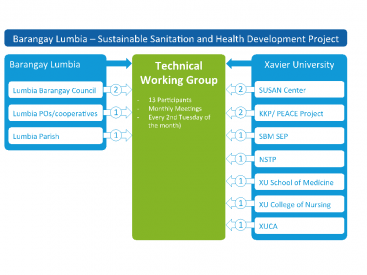
Core partners involved in the XU Convergence Project. Source: SUSAN CENTER (2012)
Activities
All activities of the members are arranged according to a module system, which is based on the tasks identified. Some modules are being handled by more than two member groups.
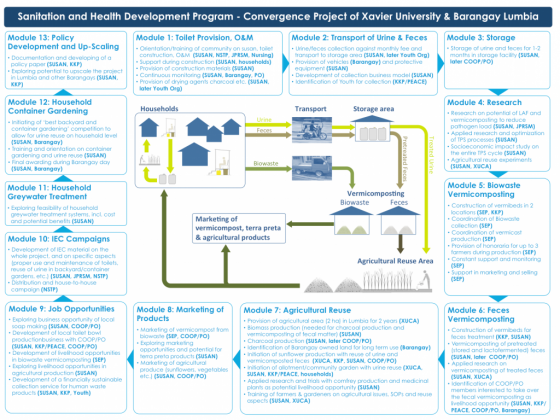
XU Convergence Project: overview of concepts and activities. Source: SUSAN CENTER (2012)
Xavier Ecoville Project
Background
On the night of December 16th, 2011, typhoon Sendong (internationally called typhoon Washi) slammed ashore Mindanao island, sending torrents of water and mud through riverside villages and sweeping houses out to the sea. XU responded immediately and mobilised all its resources available including students, faculty and staff.
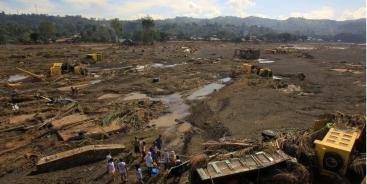
Typhoon Sendong (Washi) devastation in Cagayan de Oro. Source: BBC (2011)
Thousands of families in Cagayan de Oro (CDO) became homeless and lost all their belongings. Many of those are not allowed to return to their own areas anymore, since they were declared flood-prone areas. Others, whose houses were devastated, lack financial capacities to rebuild. Therefore, one of the major decisions XU has taken was to donate 5 of its 17 hectares of land in Lumbia in order to provide a place for a new settlement for the survivors. Around 550 households (approximately 2700 individuals) were given the chance to live on the land donated by XU.
Through the collaborative efforts of local, national and international organisations (government and non-government organisations, academic and religious institutions, as well as the inhabitants themselves) in financial assistance and other kinds of support, the whole area can now be prepared to become a sustainable permanent settlement (see also the chapter financing).
This new resettlement site is named Xavier Ecoville (XE). Since XE is located in Lumbia, it automatically became a part of the SS-HDP Convergence Project.
XE Development
Sendong survivors living in XE come from different areas in CDO. They were pre-screened by the XU (using its own criteria), before being accepted in XE.
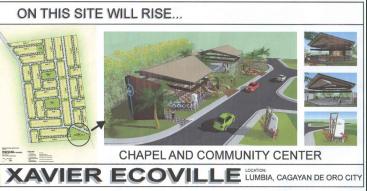
Layout of the permanent relocation site. Source: Engineering Resource Center (ERC) (2012)
While the donated 5 hectares land is still being prepared for the permanent relocation site, another 5 hectares land (owned by XU) is now utilised as a temporary relocation site for the 550 households. People are currently accommodated in temporary bunkhouses with common water, sanitation, kitchen, and electricity facilities, only until the permanent site is built up (planned for the first quarter of 2013) (see also the chapters water purification in emergencies and sanitation in emergencies).
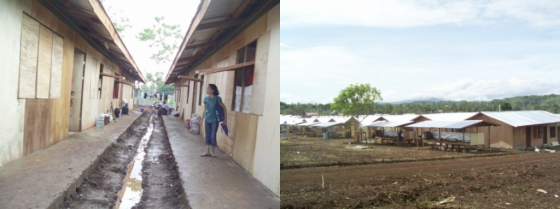
Temporary bunkhouses and drainage system. Source: SUSAN CENTER (2012)
Objectives
XE is envisioned to become an ecologically friendly, self-reliant, God-centred community. The permanent Ecoville is designed as a model community in the Philippines and around the globe, where SSWM planning and implementation approaches are applied from scratch (see also concept introduction to SSWM, planning and process tools and implementation tools).
Organisation and Activities
The Xavier Ecoville Community is assisted in becoming cohesive, self-reliant and capable of initiating and sustaining projects or activities that respond to family and community needs through effective mobilisation and utilisation of resources.
In order to facilitate Xavier Ecoville for building up a good community, the two teams, Physical Development Team and Community Building Team, were formed. While the physical development team is in-charge of any plans related to physical layout, buildings and other physical set-up for temporary and permanent sites, the community building team is responsible for values formation as well as for software and hardware needs of the community (see also planning and process tools and hardware and software implementation tools.
The Community Building Team is composed of seven clusters: WASH, Health, Education, Shelter, Governance, Environment, and Livelihood. Each team is headed by one or several persons. Their activities outlined as of now (see table) are only defined for its temporary mode. Later on, as they are transferred to the permanent site, the activity organisation will be improved and modified, according to the actual situation.
Cluster | Team | Description | Responsible Partners |
Physical Development |
| Responsible for the planning, design and layout of permanent and temporary shelters | A Brown Real State Company, UN Habitat, IOM/OIM, HRC, etc. |
Community Building Team | WASH | 1. Water (quality and supply) (see also the chapters water sources and water purification) 2. Hygiene Promotion (including hand washing) (see also hygiene frameworks and approaches 4. Wastewater Management (see also wastewater collection and wastewater treatment) | SuSan Centre |
Children, mothers, nutrition, family psychosocial stress debriefing, etc. | XU medicine medical doctor | ||
Education | Formal trainings: tutorials for students in the elementary school. Non-formal trainings: e.g. for disabled people. Moreover, non-formal education, such as training on home decoration making, hair trimming, etc. are planned for the future as part of the livelihood program. | XU college of education | |
Governance | Policies and rules for peacefulness. | Governance League Institute (GLI) | |
Livelihood | Planning activities that will support survivors to earn for a living; strong cooperation with the WASH cluster by promoting to close the loop between sanitation and agriculture through business development | XUCA and SBM |
Activities and Responsibilities on the teams working in the Xavier Ecoville temporary relocation site. Source: SuSan Center (2012)
SuSan Center: WASH Activities in Xavier Ecoville
Since the SuSan Center is not only responsible for the WASH team of XE, but also acts as secretariat of the XU Convergence Project, it has been able to integrate parts of each project into the other. This facilitates the coordination and development process of both projects.
Heading the WASH team, the SuSan Center ensures that a comprehensive management for water, sanitation and hygiene is implemented at XE. From solid waste segregation to wastewater management, the Center has done an excellent job in responding to the WASH needs of XE. In order to achieve sustainable management of water and wastewater (see also concept introduction to SSWM), residents were taught to be conscious of the 3R principle (Reduce, Reuse and Recycle) (see also the chapters optimisation of water use at home and optimisation in agriculture; wastewater reuse at home and reuse in agriculture; reuse of urine and faeces in agriculture and reuse of blackwater and greywater in agriculture).
Activity | Description | Responsible |
1. Water | Water quality monitoring | XU Biology Department |
| Water Supply: Capacity building on how to manage the water system, e.g. invalid link Construction of gutter Provision of rainwater containers for rainwater harvesting | SuSan and whole WASH team |
2. Hygiene Promotion | Provision of EC material | SuSan Centre |
| Health and Hygiene Promotion Activities | SuSan Centre, XU Medicine |
| Greening the area | SuSan Centre and Agriculture |
| Hygiene for and among the children (see also child hygiene and sanitation training) | SuSan Centre |
| Formation of the operation and maintenance committee | SuSan Centre, XE WASH team |
3. Solid Waste Management | Provision of collection bins for segregated collection of biodegradables and reusable inorganic material (e.g. plastic bottles). | SuSan Centre, XE WASH team |
| Construction of material recovery facility (warehouse) |
|
| Construction of composting pits for a pre-composting process of organic waste (and urine) | SuSan Centre, XE WASH team |
| Vermicomposting and nursery in order to reuse the compost for agriculture. | SUSAN with Ecoville WASH team and Livelihood team |
4. Wastewater Management | Monitoring the operation of sanitary facilities, septic tanks, ecosan toilets and urinals (donated by various local and international organisations, like DSWD, HRC, Red Cross and SuSan with the support of seecon gmbh, CAPS, Eat Bulaga and individuals) (see also participatory monitoring and evaluation) | SuSan Centre, XE WASH Team, XU Engineer |
| Construction of drainage (see also the chapter open channels and drains) | XE WASH Team / Ecoville residents, XU Engineer |
| Construction of drying bed for sludge, “Localized Sludge Treatment Facility” (LSTF) | SuSan |
| Construction of constructed wetland for greywater management in the temporary relocation site | SuSan |
| Construction of compact constructed wetlands for all houses in permanent site | SuSan |
Detailed Description of XU SUSAN Center and WASH Team activities. Source: SUSAN CENTER (2012)
Analysing the SSWM situation in Xavier Ecoville
The current water and sanitation situation refers to the temporary relocation site, its facilities, and implemented activities (see also the introduction to understand your system).
Housing
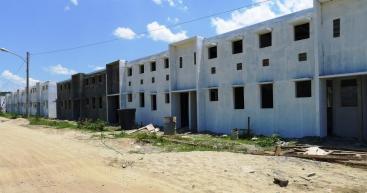
Permanent houses under construction. Source: SPUHLER (2012)
The site is equipped with bunkhouses for the 550 households. The bunkhouses were built by the Department of Social Welfare Department (DSWD) of the Philippines and by the International Organization for Migration (IOM). For the DSWD bunkhouses, one block can be occupied by 10 families (10 rooms/block), while the IOM bunkhouses can be occupied by 5 families (5 rooms/block).
Water Supply
Water is conveyed adjacent to the bunkhouses and each faucet is shared by all inhabitants of one bunkhouse. The water has been provided for free by the “Rio Verde Company” for four months. Currently, Xavier University covers the costs of the 100 cubic metre water consumption. Beyond this, the XE residents divide among themselves the payment for the water consumed. Rio Verde Water is known as clean and potable water, but people still perceive bottled water to be safer than tap water. However, there are also six sets of solarised water purifiers in XE, provided by the Ateneo Innovation Center (AIC). When tap water is treated by these purifiers, residents accept to drink it (see also water sources, water purification and point-of-use water treatment).
Toilet Facilities
The toilets blocks were numbered based on the number designated on the bunkhouses. One block of bunkhouse is assigned to use the toilets numbered according to their bunkhouse number. Two toilets are always connected to one septic tank. The effluent of the septic tanks is infiltrated and mixed with grey water (going to the open drain), whereas the solids are desludged regularly and transferred to the “Localized Sludge Treatment Facility” (LSTF). The LSTF is a sludge drying bed,located within XE, which was constructed by SuSan, IDPs and the XE WASH team.

Toilet blocks with septic tanks. Source: SPUHLER (2012)
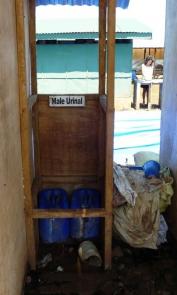
Male urinals at the Ecoville. Source: SPUHLER (2012)
Male urinals were provided outside the toilets, in order to reduce the volume of liquids in the septic tanks and thus minimise the frequency of desludging. Urine is collected regularly (1 to 2 times per week) and brought to the resource recovery facility where it is composted together with organics. Additional urine from 39 ecosan toilets (see also UDDTs), built around Ecoville in Lumbia by the pre-typhoon convergence project, are also brought to this resource recovery facility.
Moreover, 14 ecosan toilets (see UDDTs), have been constructed for the temporary relocation site. These are assigned to individual families for ownership and maintenance reasons, and are located 15 metres away from the bunkhouses, complying to international standards. The SuSan Center conducted trainings and orientation to the users, and constantly monitors operation and maintenance (see also awareness raising and invalid link, and train the trainers).
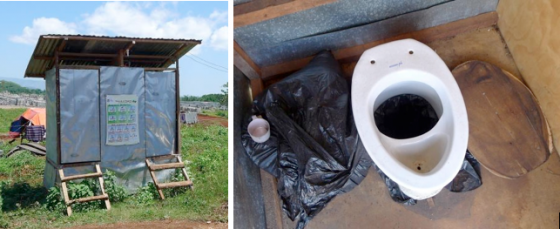
Urine Diversion Dehydration Toilets (UDDTs) at Ecoville. Source: SPUHLER (2012)

Urine composting and communal gardening. Source: SPUHLER (2012)
Black Wastewater Treatment
Sludge from the septic tanks is regularly emptied and brought to the LSTF for treatment by drying and composting (see also drying beds,thickening ponds, composting large-scale and the chapter sludge treatment). Lime, charcoal, and sawdust, plus microbial organisms, are added to the drying bed. After one year, the sludge has turned into a fertilising earthen compost which can be reused locally in the gardens and fields (see also fertiliser from sludge and use of compost).
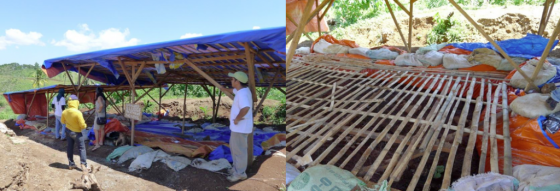
Localised Sludge Treatment Facility. Source: SPUHLER (2012)

Vermicomposting of faecal sludge (left) and throwing sludge in the LSTF (right). Source: SUSAN CENTER (2012) and SPUHLER (2012)
Solid Waste
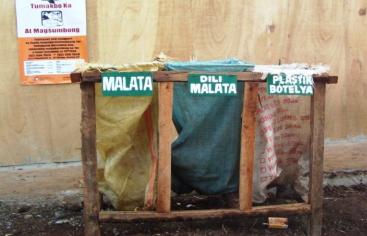
Solid waste segregation. Source: SPUHLER (2012)
All families in the area are obliged to separate their solid waste (biodegradable, recyclable, residual) using a set of special waste bins and sacks, provided per bunkhouse (see also the chapter solid waste). Recyclables are sold by the residents in the junk shop located in Lumbia. Biodegradables are pre-composted in a pit by the families and then brought to the vermicomposting site constructed by the SuSan Center (see also composting small-scale and composting large-scale). Residual waste is collected by the city garbage collectors twice a week.
Grey Water
There is one bathroom or shower per toilet block, from where the generated greywater flows directly to the open drainage (see also the chapter greywater).
Since everything found in Xavier Ecoville is freely provided by various groups, there is no uniformity in terms of the type of kitchen block or laundry block. For each of the DSWD provided bunkhouses (10 families) there is one laundry and one sink block, with 4 faucets provided. In IOM bunkhouses, 20 families are assigned to one laundry area with 4 faucets, which is always used for washing kitchen utensils. In both cases, one kitchen block is always occupied by 10 families.

Kitchen block (left) and laundry block (right). Source: SPUHLER (2012)
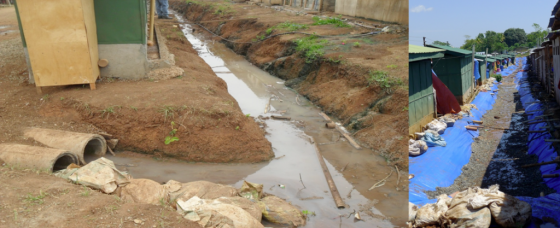
First temporary drainage system (left) and improved open drainage system with soil protecting component. Source: SUSAN CENTER (2012), SPUHLER (2012)
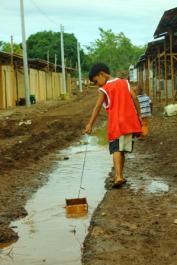
Openly flowing wastewater turns to be a playground for children. Source: SUSAN CENTER (2012)
All water from laundry and kitchen flows into the open drainage, which drains into the major tributary creek of the barangay and eventually into Cagayan de Oro River. The open channels and drains, as well as the accumulation of the water in the creek, constitute currently one of the most highest risks in the Ecoville. The open flowing, untreated drain water represents a considerable health risk at the site on the one hand, while treated grey water reuse could be advantageous on the other hand.
Product | Management strategy | Responsible Partners |
Sludge from septic tanks | Collected by a private desludging company and brought to the XE “Localized Sludge Treatment Facility”, a simple drying bed See also: septic tank and the chapter sludge treatment | SuSan, XE WASH team, residents |
Effluents from septic tanks | Currently flow into the open drainage and the creek constructed wetlands are being constructed for the permanent site | SuSan Centre, XU WASH |
Collected, treated in storage container and either used directly in the communal garden in the temporary shelter area for agriculture or added to compost. See also: urine storage, urine fertilisation and the chapter reuse of urine and faeces in agriculture. | SuSan, residents | |
Collected in households with UDDTs, brought to storage area, treated through vermicomposting process, then utilised in the garden See also: composting small scale and large scale, drying and storage of faeces, use of compost, reuse of urine and faeces in agriculture | SuSan Centre, Barangay, youth | |
Grey water | All greywater (kitchen waste, laundry waste, showers) is discharged in an open drainage. This scenario has potential invalid link to all relocates, since it is neither treated nor contained in one specific area. Because of the regional clay soil, the water is not flowing, which is why a big drainage was built. However, it still has potential for health risks and a constructed wetland is considered to be the best solution. (See also: reuse of black water and grey water in agriculture) | SuSan Centre, XE WASH team, XU Engineer |
Plastic/Residual waste | Regularly collected by garbage collectors and thrown into sanitary landfills | Barangay Council, SuSan Centre, XE WASH Team |
Solid waste; Recyclables | Resold in the junk shop found in barangay Lumbia | XE residents |
Biodegradable wastes and garden waste | Biodegradable waste is composted (vermicomposting site of XU Convergence Project). See also composting small scale and large scale, use of compost. | SuSan Centre, residents, BarangayGenerated waste streams and management approach. Source: SuSan Center (2012)
|
Generated waste streams and management approach. Source: SUSAN CENTER (2012)
Current Activities in Collaboration with the SSWM Toolbox
Wastewater Treatment
Wastewater treatment is considered a general problem in the Philippines. Even though the Clean Water Act of 2004 calls for a sewerage system in all urban areas and proper disposal of human waste in rural areas, more than 94% in urban areas and 14% in rural areas are still not connected to a sewage system, while 4% in urban areas practise open defecation (see also access to water and sanitation).
In the case of Ecoville, a conventional sewer is not an option, since it would be too cost-intensive. However, the open drainage as well as the uncertainty of water supply currently constitutes the most pressing problems in the temporary relocation site. Consequently, a wastewater management concept has been worked out by the Xavier University through its SuSan Center in collaboration with seecon international gmbh.
Constructed wetlands are considered to be a suitable solution. Compared to common treatment facilities, they are lower in costs concerning both investment and maintenance [see also the chapter financing). Furthermore, they provide an effective and natural way of wastewater treatment.
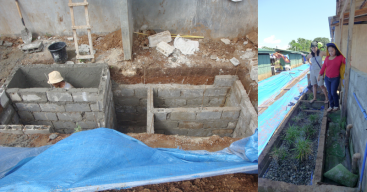
Compact constructed wetland as an example case for XU engineers and the Ecoville. Source: SPUHLER (2012)
Therefore, individual compact constructed wetlands (CCW), in combination with a three chambered septic tank, are planned to be built for each household of the permanent site. As a result, domestic wastewater will be made reusable for fertigation or irrigation purposes (see also reuse of black water and grey water in agriculture) or can safely flow into the creek (also usable for flushing toilets).
Examples of CCWs have already been built in the temporary site, while the individual wetlands for the permanent settlement are currently under construction.
The grey water treatment aims at:
- Providing a functioning grey water treatment for the Xavier Ecoville
- Providing a demonstration garden for the reuse of treated waste water
- Training XU engineers and students as well as dwellers in SSWM, constructed wetlands and reuse of treated grey water, faeces and urine in agriculture.
- Integrating this project in the developing Ecoville as well as in the existing Convergence Project
SSWM and EP&R Training, seecon international gmbh
In August 2012, the SUSAN centre and seecon GmbH organised an international workshop on Sustainable Sanitation and Water Management (SSWM) expert training in CDO. The workshop was focused on emergency preparedness and response and it made XE as its main training ground (see also train the trainers).
Different aspects related to planning and implementation of SSWM software and hardware activities in the area were conducted. All these were aimed to contribute in the improvement of the sanitation situation at XE.
19 participants coming from diverse sectors (water, sanitation, health and development) worked together for one week and were expected to come up with comprehensive SSWM approaches that are applicable for the permanent relocation site (see also concept introduction SSWM).
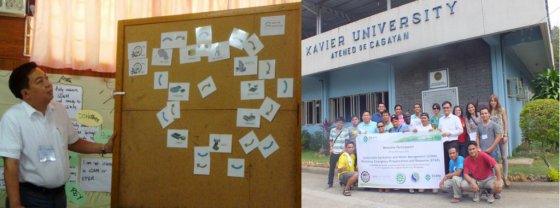
SSWM training course 2012. Source: SPUHLER (2012)
Inputs From the SSWM Training Course
Several further SSWM approaches for the Ecoville developed within the workshop. Those are now taken up by Xavier University SuSan Center in order to finalise the concept of a sustainable and self-reliant society inhabiting XU Ecoville. The main focus of the workshop results lies in making Ecoville a self-governing sustainable society as well as reaching full sustainability in the implementation of sanitation systems and wastewater treatment (see also ensuring sustainability).
Aim | Project | Means | Action |
Self-governance & independence | Community Action Plan | Making Ecoville independent from XU |
|
Self-governance & economic independence | Developing Community Self-Reliance | Strengthening purchasing power |
|
Closed loop sustainable sanitation system | SSWM System Establishment | Well planned closed loop SSWM system (see also concept introduction SSWM) |
|
Sustainable wastewater solution | Sustainable Wastewater Management | Managing waste-water sustainably |
|
Inputs for the Ecoville development from the SSWM training participants. SUSAN CENTER (2012)
As a first step towards more independence for Ecoville residents, a recent fund of 500,000 Php (approximately 12,000 U.S. dollars), from the Peace and Equity Foundation serves as initial capital for businesses being built up in XE. Prior to giving out loans, applicants now have to hand in business proposals (see also SSWM as a business).
In pictures: Philippine flood devastation
Philippine Sustainable Sanitation Roadmap
LIPortal: Philippinen
Handbuch Philippinen
Sustainable Sanitation Center
Read more about the aims and projects of the Sustainable Sanitation Center of Xavier University. The SuSan Center reports their progress in research and implementation projects on ecological sanitation in Mindanao (Philippines).
SUSAN CENTER (2012): Sustainable Sanitation Center. Cagayan de Oro: Xavier University URL [Accessed: 22.11.2012]Xavier Ecoville
The website of Xavier Ecoville reports on the progress and the happenings within the construction, operation and maintenance of the Ecoville.
XAVIER ECOVILLE (2012): Xavier Ecoville. URL [Accessed: 22.11.2012]Philippines Typhoon Washi death toll reaches 1,249
BBC Asia reported on the aftermath of Typhoon Washi on 27th December 2011.
BBC (2011): Philippines Typhoon Washi death toll reaches 1,249. British Broadcasting Corporation (BBC) URL [Accessed: 22.11.2012]Sustainable Sanitation Center
Read more about the aims and projects of the Sustainable Sanitation Center of Xavier University. The SuSan Center reports their progress in research and implementation projects on ecological sanitation in Mindanao (Philippines).
SUSAN CENTER (2012): Sustainable Sanitation Center. Cagayan de Oro: Xavier University URL [Accessed: 22.11.2012]Tropical storm Washi kills hundreds in Philippines; may be 2011’s deadliest storm to strike globe
The Washington Post reported on tropical storm Washi on 19th December 2011.
SAMENOW, J. (2012): Tropical storm Washi kills hundreds in Philippines; may be 2011’s deadliest storm to strike globe. The Washington Post URL [Accessed: 22.11.2012]Tropical storm Washi hits the Philippines
Read the WHOs report on the aftermath of Typhoon Washi and their activities on site in order to prevent and curtail the outbreak of water borne diseases and epidemics.
WPRO (2012): Tropical storm Washi hits the Philippines. Emergency and Humanitarian Action Repor. World Health Organization Western Pacific (WPRO) URL [Accessed: 22.11.2012]Xavier Ecoville
The website of Xavier Ecoville reports on the progress and the happenings within the construction, operation and maintenance of the Ecoville.
XAVIER ECOVILLE (2012): Xavier Ecoville. URL [Accessed: 22.11.2012]Sustainable Sanitation Center (SUSAN Center)
The Sustainable Sanitation Center (SUSAN Center) is a multidisciplinary convergence center of Xavier University. The SUSAN center is committed to a science-based and multi-sectoral engagement in sustainable sanitation, aiming to achieve a cleaner and healthier environment and promoting human dignity for peaceful and sustainable development in Mindanao, the Philippines and the wider Southeast Asian region. The SUSAN centers core activities include capacity development of communities, policy makers and other institutions on sustainable sanitation and to support the development and implementation of various sustainable sanitation technology solutions.
http://tabangsendong.xu.edu.ph/
The website of Xavier Ecoville reports on the progress and the happenings within the construction, operation and maintenance of the Ecoville.
